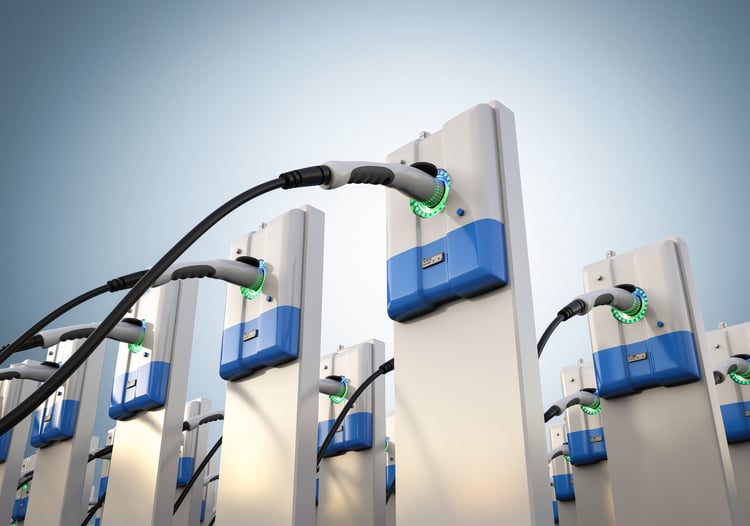
In our last blog, we discussed the attractiveness of DC fast charging for EV drivers. A 250 kW DC fast charger can charge a standard EV to 80% power in 15 minutes, making a charging session almost the same as filling your gas tank in an internal combustion vehicle. For charging network operators, this attractiveness is tempered by the high cost of these chargers, which are believed to run from $50,000 to over $200,000 each. However, this is an area where charger manufacturers and their ecosystem of vendors are working on ways to reduce the cost of DC fast chargers. In this blog, we will explore some of the approaches being used to make this happen.
The Anatomy of Today’s DC Fast Charger
Before we jump into how DC fast chargers are becoming more affordable, let’s look at the basic architecture that drives these costs. The current “state of the art” for DC fast chargers is an architecture known as an “Integrated Gate Bipolar Transistor” (IGBT) architecture, which consists of the following parts (see illustration below):

-
Power Conversion Unit: The Power Conversion Unit (PCU) converts AC input power into the DC power which eventually is provided to the EV. Most PCUs are the size of large commercial refrigerators (roughly 6’ H x 4’ W x 2’ D, but these vary by vendor).
-
 Main Isolator, Fuses, and Transformers: The input power to a DC fast charger tends to be a high-voltage output from a substation, with a voltage range of 380 to 600 VAC three-phase power. For a 250kW fast charger running on 600 VAC three-phase power, the input current on each of the three legs can be close to 400 amps root-mean squared (RMS). This requires high-voltage, high-current, high-speed isolators and fuses. Moreover, galvanic isolation is also required to keep the PCU safe from voltage excursions in the EV or on the utility lines.
Main Isolator, Fuses, and Transformers: The input power to a DC fast charger tends to be a high-voltage output from a substation, with a voltage range of 380 to 600 VAC three-phase power. For a 250kW fast charger running on 600 VAC three-phase power, the input current on each of the three legs can be close to 400 amps root-mean squared (RMS). This requires high-voltage, high-current, high-speed isolators and fuses. Moreover, galvanic isolation is also required to keep the PCU safe from voltage excursions in the EV or on the utility lines. -
IGBT Inverter: The IGBT inverter is the heart of the PCU. It takes three-phase AC power from the transformer, and switches it on and off to charge up large capacitor banks in the inverter. The goal is to maintain a constant DC voltage to the dispenser (and from there to the EV batteries), while managing the current to avoid overheating the batteries. In this function, the IGBT inverter is controlled by the Communications and Power Control Module, which communicates with the EV interface module and (eventually) with the EV battery control system itself. A typical IGBT inverter today is roughly 95% efficient, meaning that only 5% of the input power from the grid is lost as heat. While this is good, for a 250kW fast charger that means that 12.5kW of energy is lost as heat.
-
 Communications and Power Control Module: This module provides two functions: i) it acts as an intermediary with the EV interface module and the IGBT converter to ensure the right amount of power is going into the EV’s batteries; and ii) it acts as a communications relay between the credit card reader and display system, and an outside communications to the charger operator’s billing system, usually through either a cellular interface or a hardwired network.
Communications and Power Control Module: This module provides two functions: i) it acts as an intermediary with the EV interface module and the IGBT converter to ensure the right amount of power is going into the EV’s batteries; and ii) it acts as a communications relay between the credit card reader and display system, and an outside communications to the charger operator’s billing system, usually through either a cellular interface or a hardwired network. -
Cooling Unit: The cooling unit provides cooling for the entire PCU (usually through a system of fans) to eliminate the 12.5kW of heat generated by the IGBT Inverter.
-
-
Dispenser: The dispenser is the unit that sits “near” the vehicle, and provides the interface to the user and the vehicle. Its components include the EV interface module (used to communicate with the EV battery system), a credit card reader and display (allows users to swipe their credit cards, or use an RFID card to authorize charging), and a liquid cooling system to cool the dispenser cable (dispenser cables usually use smaller conductors than the underground cabling to keep weight down and increase flexibility, making it easier to handle the dispenser nozzle).
In general, the higher the switching frequency of an inverter, the more efficient they are. IGBT inverters generally switch at frequencies of 20kHz to 30kHz, which is limited by the switching frequency of the transistors. However, these lower frequencies mean that the magnetic and capacitive components are fairly large, increasing the weight and cost of the PCU. Our next blog will look at the technologies driving improved efficiency and lower costs in DC fast chargers for EVs.

